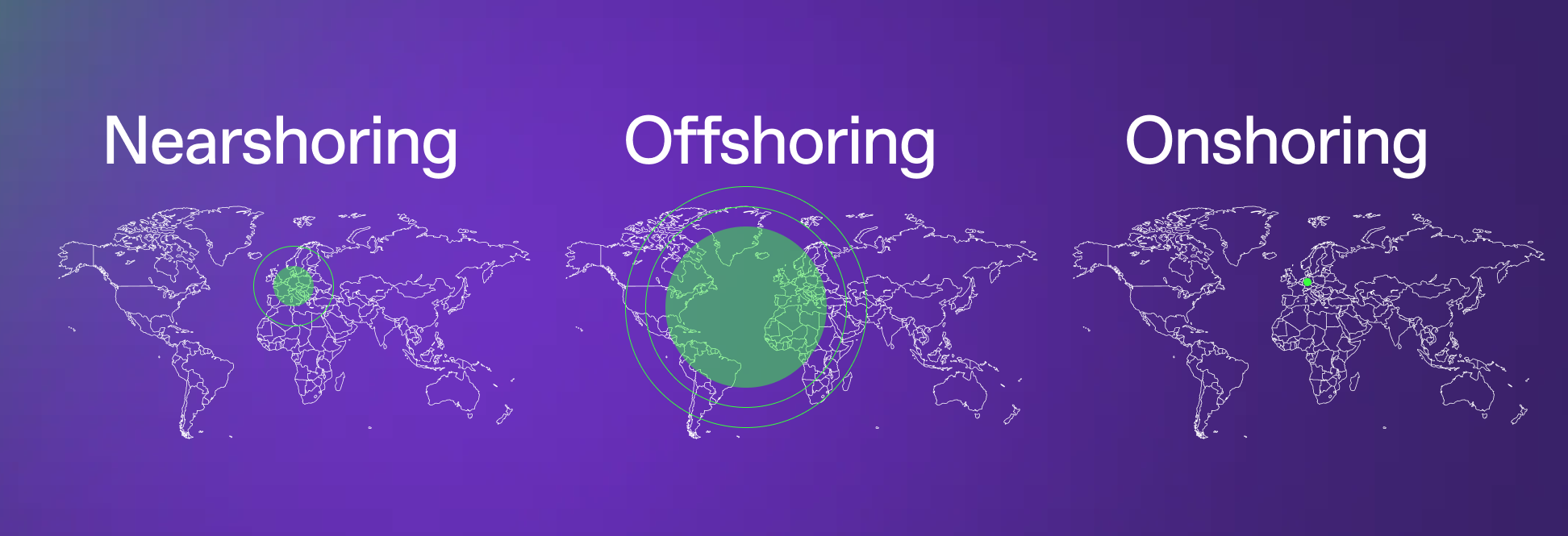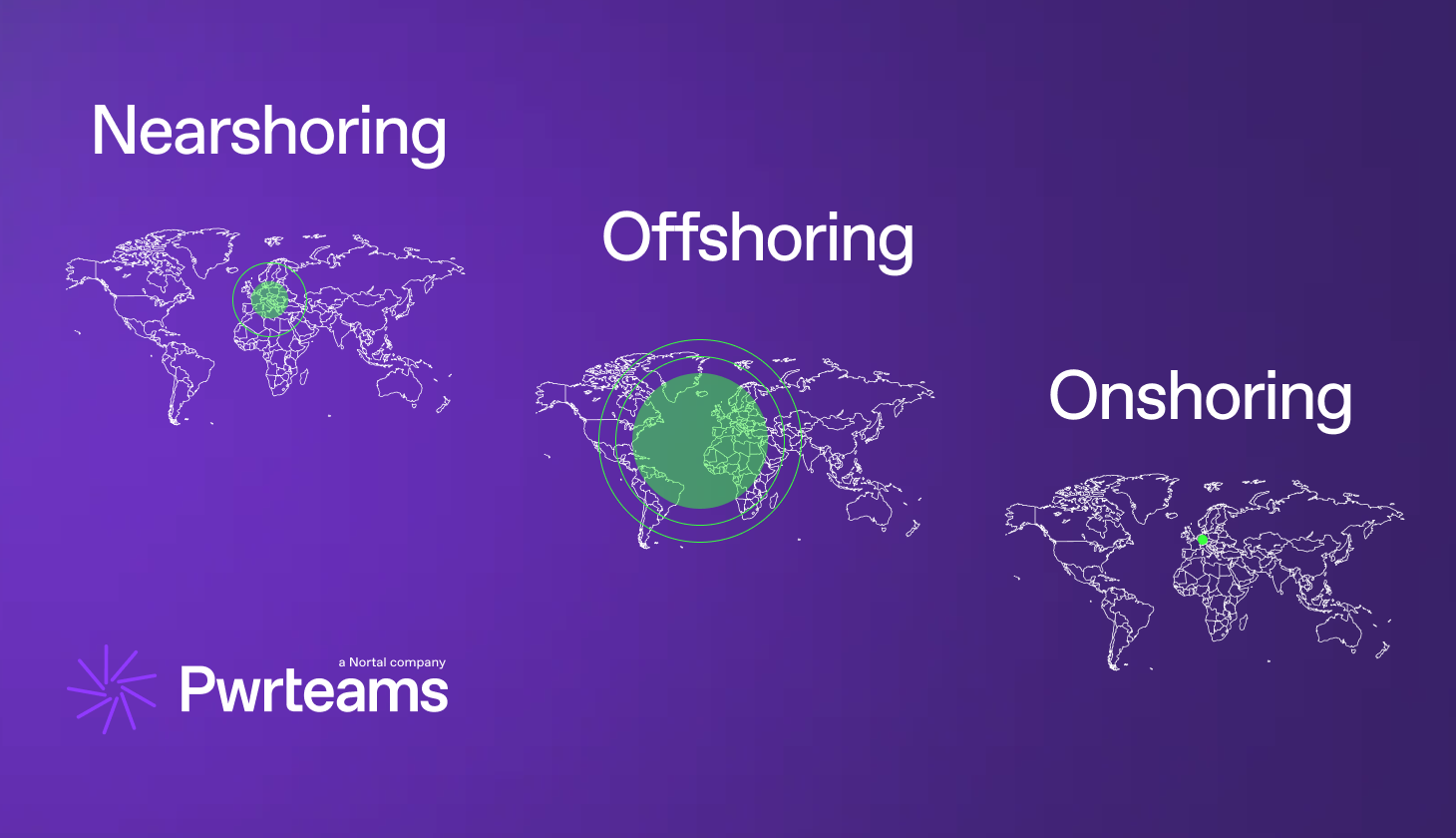Nearshoring vs. offshoring vs. onshoring - which, when and why?


Building a new digital product is challenging. Be it a mobile solution, an IoT app or a website, you’ll need to handle the development process and run a business at the same time. 72% of companies have found a solution, and it’s outsourcing.
We’ve already covered the difference between outsourcing, outstaffing and development centers in our previous article. This time, we’re going to talk about the three main layers of outsourcing: offshoring, nearshoring and onshoring. Let’s learn the difference between them, understand the risks and benefits you can expect from choosing one or the other and select the approach that meets your business needs.
Nearshoring vs. Offshoring vs. Onshoring
So, you’ve decided you don’t want to spend too much money, time and nerve cells on the recruiting process. That’s understandable. Luckily, you can turn to one of the common approaches to outsourcing: nearshoring, offshoring and onshoring. While they all represent the same notion of paying a third party to do some work for your company, understanding the differences between them is critical.
Offshoring is known as the most budget-cutting approach to outsourcing. Companies offshore their processes to outsourcing vendors in distant countries, usually India, China or the Philippines, where the talent pools are full and the expenses are low. The timezone difference here plays a significant role in keeping your business work around the clock.
Nearshoring means outsourcing to a nearby country, preferably a neighboring one or that’s at least on the same continent. This helps to travel and hold face-to-face meetings more frequently, at a lower cost. You can also get more control over your business if you visit often and keep the team spirit high by inviting the development team to your HQ. The cultural compatibility reduces any chances of misunderstanding and facilitates work coordination.
Onshoring is basically outsourcing to another city in your country. By using this approach, companies don’t face the risks associated with offshoring like cultural differences or foreign taxing policies, not to mention they invest in their country’s economy.
Here’s a TL;DR for you:
If a Belgian company outsources to Chile, that’s offshoring.
If a Belgian company outsources to Ukraine, that’s nearshoring.
If a company from Brussel outsources to Ghent, that’s onshoring.
So, what should you choose: nearshoring, offshoring or onshoring? Let’s dig deeper into their pros and cons to find out.
The Pros And Cons of Offshoring
When you feel that your current staff can’t handle the workload, it seems logical to hire more dedicated in-house employees. But, usually, hiring an in-house team is more expensive than some companies can afford. That’s when they turn to offshoring. And though it remains a popular approach to software development, some questions remain unanswered. What are other benefits except for lower costs? Are there any hidden pitfalls? Is it a panacea for all the troubles CEOs face or is it just another hype? Let’s have a closer look at the benefits and drawbacks you may encounter.
Run Your Business at a Lower Cost
It’s a very competitive market, so many offshore outsourcing companies establish the best conditions possible for their clients. They can even charge nothing for services like short-term support. CEOs who choose offshoring may also benefit from reduced or even 0% business taxes. Also, it gives companies an opportunity to expand into the new market without extra expenses.
Choose from the Best
Offshoring gives you a wide range of choices. You can expand your staff choosing professionals from a large talent pool. A decent outsourcing vendor usually works with many customers, which allows them to understand the current issues and trends in the industry. You are welcome to use this experience to your advantage. According to Deloitte’s Survey, over 50% of participants agreed that third-party companies added value during the business development process.
Get Work Done While You Sleep
The timeshift might look like a drag, but you can turn it around into a benefit. Say, your iOS developer is building your new product in Portland, Oregon. While she’s asleep, your other employee from Dalian, China, is testing the functionality she’s developed. By the time she wakes up, the tester had already logged a critical bug she can fix by lunch. Profit! You can also send your instructions before going home in the evening and come to the office the next morning to find the tasks delivered. BTW, offshoring is not limited to software development; you can use it for marketing, reporting, support services and so on.
The Need for Constant Control
Since offshoring involves working with a team that’s far away, you might feel like you have to always control their actions to know what they’re doing. Flying there once a week is not an option – the road will take an entire day. One day you can find yourself on the phone with the outsourcing manager in the middle of the night on a Saturday. What’s worse, the lack of regular face-to-face contact may pose a threat to intellectual property or end up in a con game.
To protect your business, you need to establish trustful and long-lasting relationships. While building your remote team, make sure you hire self-directed workers. In the book Rework, Basecamp calls an employee like this a “manager of one.” Divide your workflow so that every member of your team has its own specific area to work on. Make sure each of them can self-direct their work and won’t require constant attention and approval.
The Pros And Cons of Nearshoring Teams
A lot of CEOs have second thoughts about outsourcing software development. If you run a startup or a small company and want to give outsourcing a try, before breaking into offshoring, you might like the idea of nearshoring.
Benefit from Geographical Proximity
The geographical proximity allows less expensive trips and more frequent face-to-face meetings. Don’t underestimate the power of in-person communication. It can increase the output of your teamwork and help mitigate sudden expenses that cause confusion and surprises down the line. The possibility to collaborate in real-time reduces the chances of misunderstanding during the workflow.
Closer Cultural Compatibility
By living closer to each other, you and your partners will encounter fewer problems concerning cultural differences. You can also find that you speak a similar or even the same language, which will make your communication faster, easier, and more effective. And don’t forget that the vendor’s country may also have similar taxing and financial laws.
Poor Selection
Nearshoring can guarantee fast communication and timely decision-making. However, the number of providers may be lower, so you may face the challenges of finding the right vendor to meet your project needs.
The Pros and Cons of Onshoring Teams
When you’re just starting out as a business owner, you want to gain security, control and coordination over as many processes as possible. This is where onshoring can help you out. Onshoring is an excellent choice for startups and innovative projects that are broadly defined or not well-documented.
You can Find Cheaper Options
True, onshoring is more expensive that nearshoring and much more expensive than offshoring. But you can always find a bargain. The research on Harvard Business Review shows that workers from northern France, eastern Germany and southern regions of the USA charge less than those in Western metropolitan areas. If you strive for more transparent communication and effective control, select employees from smaller cities.
Invest in Your Country
Onshoring guarantees even more efficient coordination and cooperation since all the participants of the process are from a single cultural and language background. Along with real-time cooperation, security and control the companies get, onshoring brings jobs back to the native labor force. They also use domestic tools, facilities, and infrastructure.
Arm Yourself with Patience
Sadly, onshore companies may lack the required candidates. So, if you decide on onshore outsourcing, you need to consider the time to recruit and train the candidate you need or reach out to Pwrteams for assistance.


Summing Up
At first, it may seem like the difference between offshoring, nearshoring and onshoring is only the distance. But in our digital world, territorial proximity shouldn’t be your key factor when deciding which of these outsourcing approaches to consider. First, you must set your priorities straight and define what you’re trying to achieve by adding new blood to your team. What do you expect? Is it the lowest cost, the least fuss or a balance of everything?
Only when you have a clear vision of the responsibilities, the duties and the required skills of your future employees, you can decide which approach to go for. And if you still have questions related to software outsourcing, don’t hesitate to contact Pwrteams for more info.
 September 29, 2025
September 29, 2025
Build your team or extend with ours? Here’s what helps fintech CTOs decide
Read the post September 10, 2025
September 10, 2025
Fixed-price projects vs dedicated teams: A fintech CTO comparison
Read the post September 3, 2025
September 3, 2025
How burnout is crippling tech leadership in the Nordics and Benelux
Read the post September 29, 2025
September 29, 2025
Build your team or extend with ours? Here’s what helps fintech CTOs decide
Read the post September 10, 2025
September 10, 2025
Fixed-price projects vs dedicated teams: A fintech CTO comparison
Read the post September 3, 2025
September 3, 2025
How burnout is crippling tech leadership in the Nordics and Benelux
Read the postWrite your own
success story
with Pwrteams!
Share your details in the form, tell us about your needs, and we'll get back with the next steps.
- Build a stable team with a 95.7% retention rate.
- Boost project agility and scalability with quality intact.
- Forget lock-ins, exit fees, or volume commitments.